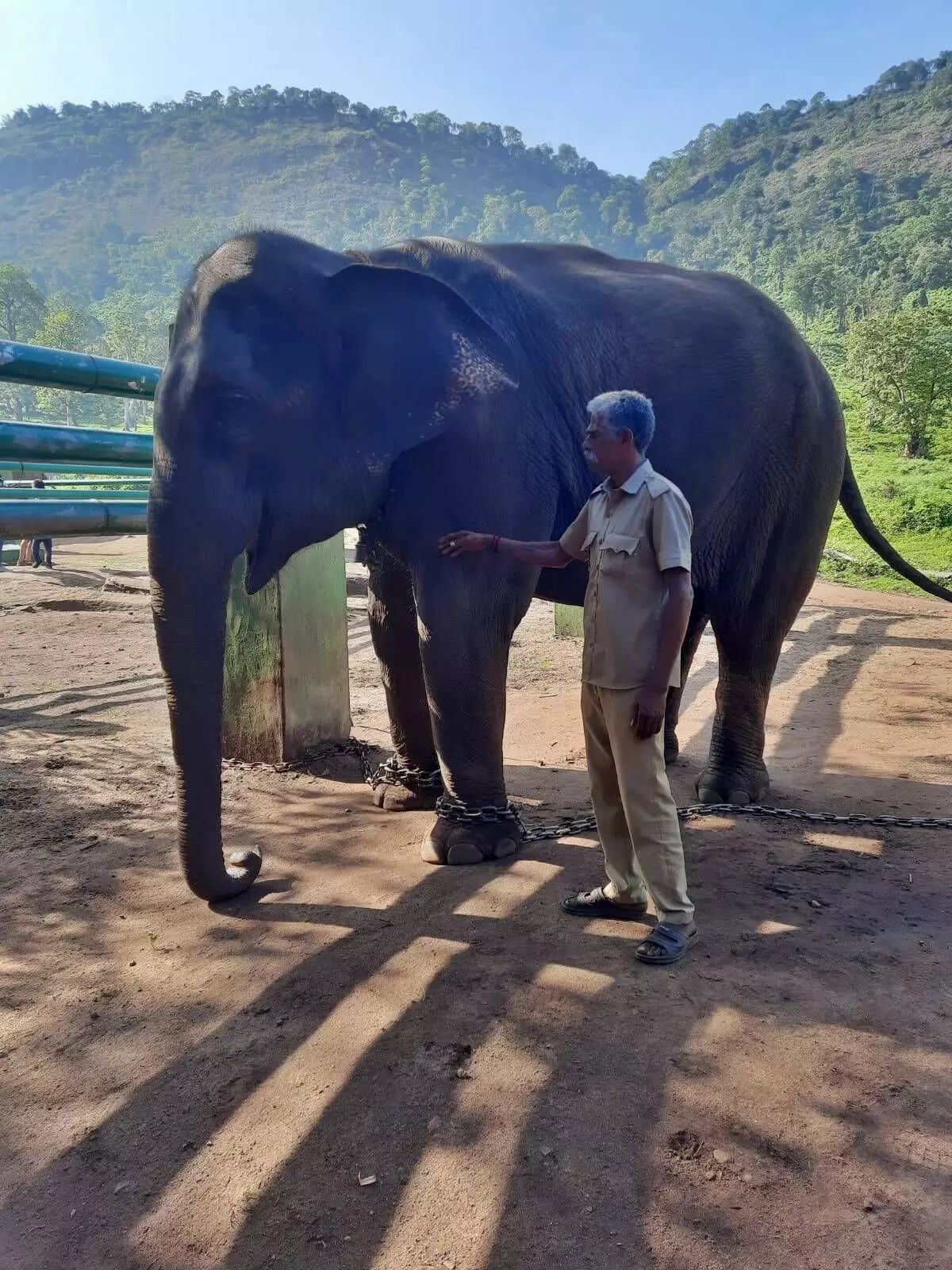Top Slip (Coimbatore), Tamil Nadu
Andal, Kapil Dev, Sharada, Tamilan, Durga, Saravanan, Uyiran, Chinnatambi… they shuffled around as they waited for the feast of the day — a delicious and nutritious mix of cooked ragi, horse gram and rice kneaded together with salt and jaggery. They knew that once the main course was over, their favourite dessert awaited them, sugarcane. They were impatient, and I could sense it as I stood patting Devi.
Suddenly, there was a deep rumbling roar, and I stepped back in alarm. Devi was obviously tired of random strangers coming up to stroke her raspy trunk and gawk at her, and she made her irritation loud and clear, and even the bell around her neck jangled angrily.
Palaniswami, her mahout, tut tutted and gently reproached her and assured me she was harmless, but I kept a respectful distance. Devi made short work of lunch and then pointedly looked away from us.
We are standing at the Kozhykamuthi Elephant Camp on Top Slip. This camp came into being in 1956, but elephants were brought here long before that. Since the mid 1800s wild elephants from the forests were captured and trained at Top Slip to carry timber. Top Slip falls in the Anamalai Tiger Reserve in Tamil Nadu in the Western Ghats and is part of the protected Indira Gandhi Wildlife Sanctuary.

The mahouts and kavadis (helpers to mahouts) at the elephant camp at Top Slip are full of incredible stories about their wards.
Devi originally roamed the forests at Thiruvannamalai, more than 300 kilometres away from Top Slip, and was part of a herd of six elephants. “The herd had begun to raid villages and was captured. Three elephants, including Devi came to Top Slip, while the three others went to Theppakadu, in the Nilgiris,” Palaniswamy said. Theppakadu Elephant camp in the Mudumalai Tiger Reserve in Nilgiris district is where Elephant Whisperer was shot.
The elephants at the camp are kumki elephants, which are used to capture or chase back into the forest elephants that wander into human settlements. Elephants here have also rescued injured elephants and helped calm newly inducted elephants into the camp. Often orphaned and abandoned elephant calves are brought here and the ‘senior’ elephants settle them in.
Before Devi, 46-year-old Palaniswamy looked after an elephant named Kalpana Chawla who was famous as Asia’s tallest female elephant. She too was part of a herd that constantly strayed out into Sethumadai village nearby, and because she was the tallest it was assumed she was the matriarch of the group and was captured and brought to the camp. Sadly, Palaniswamy said, she died of a stomach ailment.
The mahouts and kavadis (helpers to mahouts) at the elephant camp at Top Slip are full of incredible stories about their wards. The mahouts and kavadis all hail from the Malasar and Kadar tribal communities, indigenous to this region. They are forest people who have coexisted with birds and beasts for hundreds of years.
Surrounded by forests, the camp was a bevy of activity on the sunny morning as it was feeding time. In a big room, mahouts stood in a row kneading together cooked ragi, horsegram and rice along with jaggery and salt. Big balls of those were carried out and fed to the elephants.

The elephants at the camp are kumki elephants, which are used to capture or chase back into the forest elephants that wander into human settlements.
Also Read: The “idiot jumbo” who strayed out of “his home” and ruined my Sunday!
Just then, Kaleem with his mahout sitting atop him swayed past. The stately elephant retired just recently after a stellar career spanning 50 years!
“He was rescued as a calf in the Sathyamangalam forests and brought here in 1972,” Pravin Shanmughanandan, Founder, Pollachi Papyrus, a conservation portal, told Gaon Connection. Kaleem was honourably and ceremoniously retired with a guard of honour when he turned 60. He took part in nearly 100 operations to capture more than 25 wild elephants in Tamil Nadu, Andhra Pradesh and Kerala over the past 20 years.
There are big green boards put up at the camp listing the names, ages and the origins of each of the elephants that are there today. One of them is Mariappan.
The lone tusker stood against the forest trees in the middle distance, moving his head side to side as if vehemently disagreeing with something an invisible companion was telling him, and obviously he was not ready for lunch yet.
“Mariappan is stressed about something. He had a falling out with the kavadi, (helper to the mahout) recently,” Palaniswamy said. They will approach him with some caution, once he has cooled off.
Also Read: Rescued elephants find a home, away from home
“The elephants have moods too, just like we do. And we understand each other perfectly,” said Palaniswamy who can’t remember being anywhere other than with elephants since his childhood. His older brother, uncles have all been mahouts.
The oldest elephant in the camp is Shivagami, who is 74 years old. These elephants live up to a hundred, said Palaniswami. Shivagami was at the water tank having a leisurely shower.
The elephants are also allowed to go into the forests everyday and are well looked after. As we prepared to leave, they were being readied for a health check up by a team of veterinarians from Chennai and Coimbatore.


















